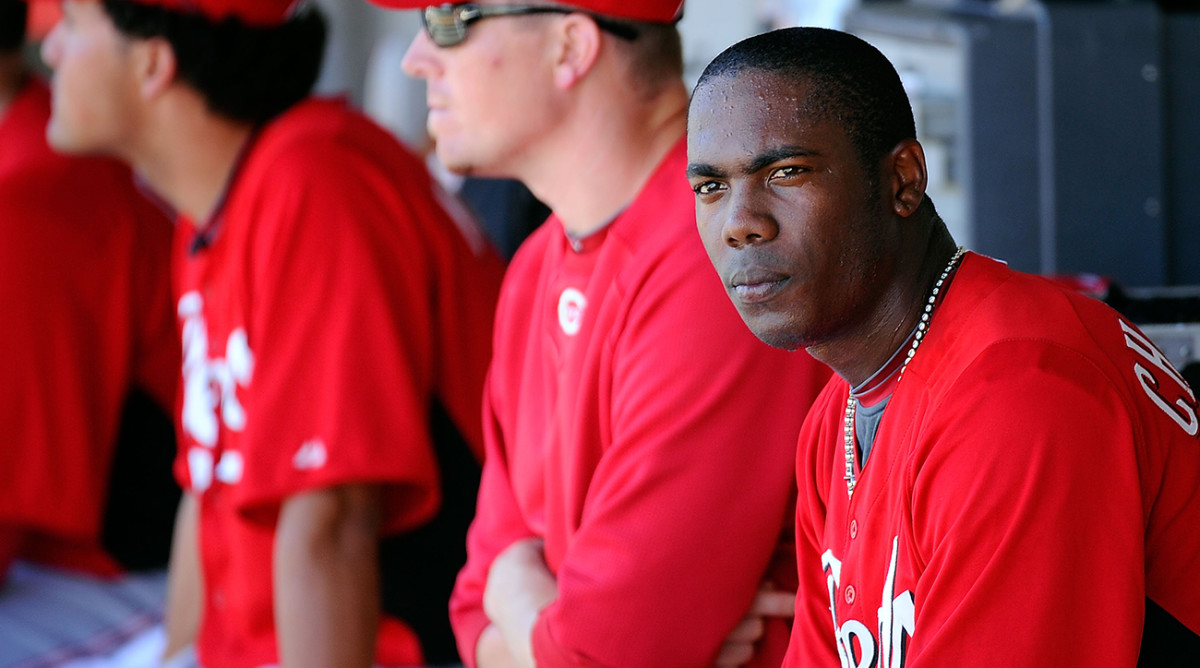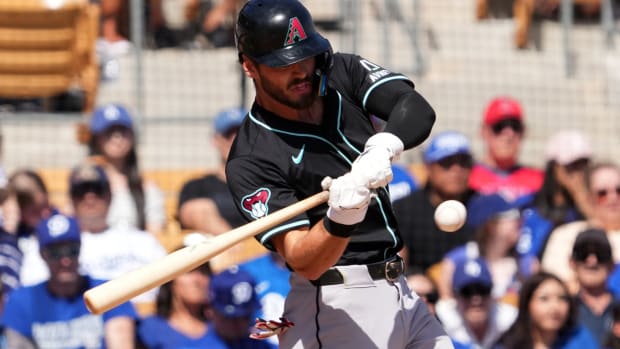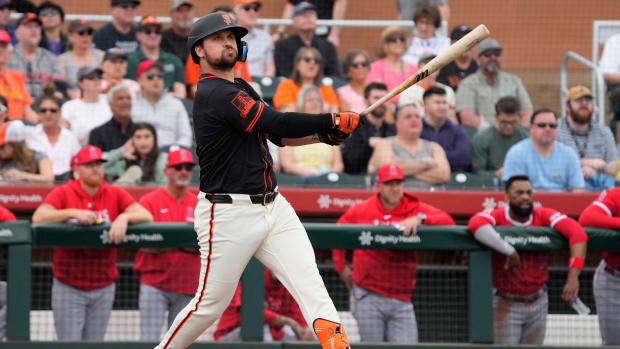
As Reds' Chapman Recovers, Dangers of Line Drives Hit Close to Home
Within a day, you could feel the fear and horror begin to recede -- just as it always does. Aroldis Chapman was going to be fine, the team doctor said. The crushing line drive that leveled the Cincinnati pitcher last Wednesday, sent him face-down and flailing onto the grass in Surprise, Ariz., had produced a mild concussion but no brain damage. What first had been diagnosed as "facial fractures" was downgraded to "a fracture above his left eye". It's "absolutely" reasonable, the doctor said, to think the hardest-throwing man in baseball would pitch this season.
So again, at least for those who've never experienced the assault of a batted ball, it all fades. The brutal TV clip gets filed away, right there in the same folder with names like J.A. Happ, Brandon McCarthy, Al Albuquerque, old-timers like Bo McLaughlin and Herb Score and, of course, Mike Coolbaugh. Maybe there's still some talk about the protective caps that major league baseball is now allowing for pitchers. But it's spring training. Questions need to be answered. The fifth starter. The lineup. The guys who'll be sent down.
But for others, many of whom never got a sniff of pro ball, each new incident brings back fresh their bad moment. Friends, old teammates and family can't help but reach out. "When Chapman got hit, my phone blew up with text messages," said Jimmy Silk, coach of the Wilson High baseball team in Washington D.C. "The people who were there and saw it and heard the sound of the baseball off my skull? I don't remember it. But they'll remember that the rest of their lives."
That was May 3, 2000. Silk, a lefthanded pitcher for Sandwich (Mass.) High, had fired a 2-0 fastball and fielded the harsh reply just above his left ear. He fell; the third baseman caught the ricocheting ball for an out. Blood seeped beneath the skull. Before going in to operate, the surgeon told Silk's parents that he didn't know if their son could be saved. He carved a hole to relieve the pressure, sutured an artery. He also told the Silks that he didn't know if Jimmy would ever be the same.
Silk missed a year of school, essentially had to relearn how to speak. It can take a skull more than a decade to heal; even now, at 28, he is legally deaf in his left ear and stutters more than he'd like. He pitched for three more years. To this day, his mom calls every May 3 to congratulate him on being alive.
Mangled teeth. Broken faces. Blood streaming down a jersey. I've become used to writing such phrases. In 2008, while researching a book on Coolbaugh, the minor league first base coach killed by a line drive in 2007, I became a one-man clearinghouse for all the freak accidents that have speckled baseball history. I learned that every longtime baseball man had at least one horrific story to tell. I learned about the minor league bat boy killed, the major league umpire killed, and the two fans -- one in Los Angeles and one in Miami -- killed, too.
Yet, even knowing that, it's remarkable how quickly I could forget it. If anything, spending time with so many devoted, obscure lifers made me embrace the game more, its rhythms and unyielding core. Once, returning from a trip to see Coolbaugh's mourning family, a week thick with loss, I hustled my oldest son to a local batting cage. Ignoring the warnings, I stood in the doorway as he took his cuts. One foul ball nearly parted my hair.
On paper, of course, I'm outraged that baseball hasn't done more to protect its pitchers and fans. Every pro stadium should have screens extending to the outfield wall, for one. The shift to Bbcore bats has helped on the high school level, but the padded caps approved for use haven't gained much traction among players: Too bulky, too hot, too uncool. One problem is that not even a helmet -- the kind that became mandatory for corner coaches after Coolbaugh's death -- would have helped Coolbaugh or Chapman, who were struck in the neck and forehead, respectively. The only real solution remains a softening of the ball itself -- and good luck putting even the smallest tweak there up for discussion.
"Sacrilegious," Silk said. "But if they're so concerned about the base coaches who are more than 90 feet away, why there's very little concern about pitchers who end up 57 feet away from home plate in an unbalanced position is beyond me. And the more I see it happen on the college level and the major league level, the more I think nothing will change until a pitcher is killed on television."
Silk thinks it will happen. So do I. Players are stronger and fitter than ever, and nothing will change that moment of vulnerability for the pitcher after the ball has left his hand: On one leg, arms splayed, head lunging and exposed. To see the Chapman footage, with a ball sizzling back at more than 100 mph, is to wonder why a prime-time manslaughter hasn't happened yet.
"Around the same time I was hit, Bryce Florie of the Red Sox took one in the eye socket and that more or less ended his career," Silk said. "Growing up playing baseball, I always had a sneaking suspicion that it would happen to me. Why? I don't know. So when it happened I wasn't surprised. Even today, throwing batting practice, every pitch you throw you think about it. It's a hard thing to shake completely, because it ends up shaping you as a person."
Still, Silk kept playing until someone took the uniform away. He's been coaching now for a decade, hearing the ball crack off the bat, a local hive for insight whenever a comebacker lays someone out. I bring this up to him -- his staying close to the game that hurt him -- but Silk is polite: He doesn't throw it back in my face. He doesn't ask me what I'm thinking and, really, I'd have no answer if he did.
My son plays for Silk. He's a pitcher, a lefthander like Chapman and his coach, and at 18 he's never come close to being hit by a batted ball. The other night I suggested that he watch the Chapman footage, and instantly regretted it. Would it make him safer? More fearful? Less aggressive? Less safe? The odds against such an incident occurring are monumental. And yet. ...
Spring arrived this week. Here in D.C., the fields are drying out at last. The players have had it with gym work; they're desperate to be outside. And I'm like every other fan. There'll be games to see and I love watching a lefty work: Ball over the top, wrist-snap, and then for an instant on his drift toward third the pitcher hangs as if suspended, arm dangling, body about to fall. He looks so damned helpless. Any praying begins then.


































